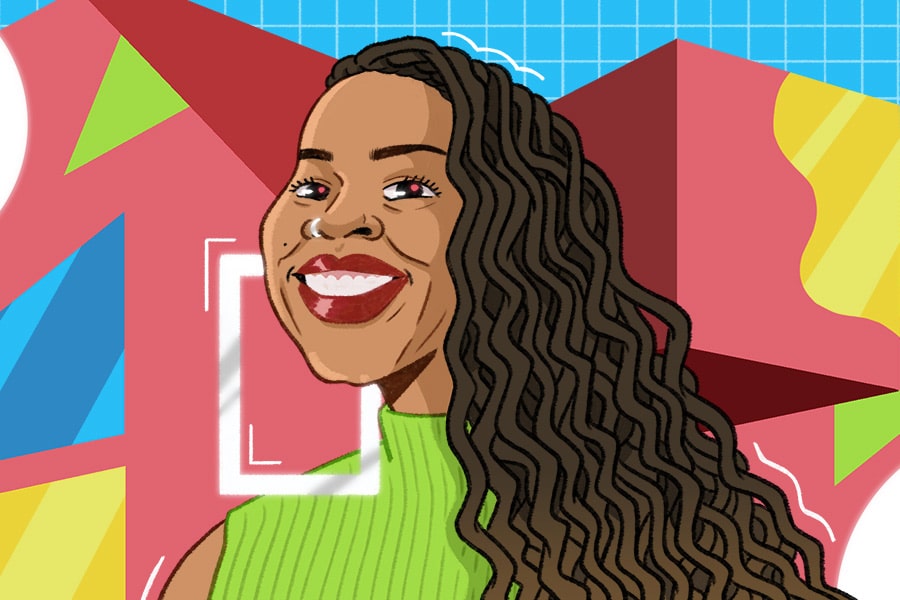Log onto a-l.hu, the website of architect, activist and organizer A.L. Hu, and you will see a single page with four lines containing static and scrolling text. Beneath the name at the top, the text on the second line reads: “I am a” and next to it scrolls terms such as “glittery person,” “curious activist,” “feminist cat-person,” “non-binary designer” and “organizer.”
The third line includes things Hu is invested in, such as “inclusive equity,” “queer spaces,” “queer representation” and “gender architecture.” At the bottom of the page is a link to Hu’s Twitter profile.
Identity is hugely important to Hu, who identifies as a queer, non-binary person working in New York City with the pronouns they/them. Their day job is design initiatives manager at Ascendant Neighborhood Development Corporation, an organization that creates affordable housing and works to help the communities of East and Central Harlem. Hu started working with Ascendant in October 2019 through the two-year Enterprise Rose Fellowship, linking promising architects with community development organizations.
Outside of work, Hu is co-creator of Design As Protest, a collective of anti-racist designers working to make the industry more inclusive; founder of Queeries, an initiative to give voice to the experiences and feelings of queer designers; and an active part of organizations such as The Architecture Lobby, QSPACE, ArchiteXX and AIA New York.
Through this work, Hu is emerging as a vital voice in the architecture and design industry, advocating for much-needed change and inclusivity. But none of this would be happening if it not for a boring economics class they took in college.
“I had a really great economics teacher in high school and decided to apply to UC Berkeley for economics and got in, but then I took one econ class and realized I was falling asleep,” they said. “I set out to find a new major and happened upon an intro to architecture class. I took it and really enjoyed the creativity and freedom, so I kept with it.”
Owning their identity and speaking out
Hu graduated in 2012 with a degree in architecture and sustainable design, went to work at a residential architecture firm in San Francisco and two years later was accepted into Columbia University’s Graduate School of Architecture, Planning and Preservation. Flying across the country to start a new life was a revelation for Hu, and they noticed a difference in themselves almost instantly.
“I’d always had really long hair; I felt like I could hide behind it, and it was a way of shielding myself from the world and the world from me,” they said. “But when I got to grad school, I cut off my hair and got a pixie cut. I felt like I needed to get out of my comfort zone.”
Step out of their comfort zone, they did—and in a big way.
Within their first semester, they were elected to student government, thereby forced into a public role within the university, often working with unions to advocate on behalf of rights and fair wages for graduate students. During the summer between their first and second year, Hu came out as non-binary.
“I was realizing that I didn’t identify as a woman, and I think realizing that also had a lot to do with the way I approached design,” Hu said. “It really got me to think outside the box to understand that there is not a single right way to be an architect.”
ALSO ON BUILT:
Adriana Barcenas Rojas, who attended graduate school with Hu and today also collaborates with them as part of Design As Protest, appreciated Hu’s intentional questioning of the field while at Columbia.
“I remember when conflicts would arise—issues in the profession—and they would always be proactive about helping to change things for the better,” she said. “A.L. never shied away from letting administrators know when things needed to be addressed.”
One of the major issues Hu grappled with during school was the studio model in classrooms in many architecture schools and how it can lead some students to turn away from the profession after graduating.
“When you’re in a studio, you’re with a class of maybe 12 other students and an instructor who is trying to teach you a certain way to do things,” they said. “I pushed against that because I believe there isn’t a one-size-fits-all way of designing. I believe that grad school and design education should be about figuring out your own process and not necessarily trying to follow all of the rules.”
Advocating for change
Today, Hu is thrilled to combine their passion for community and organizing with design in their fellowship work with Ascendant, and the organization is happy to have them on board.
“No one on our team—other than A.L.—is an architect; to have them on staff and bring their host of skills to our internal team has been hugely transformational for us,” said Christopher Cirillo, Ascendant’s executive director, adding that he hopes Hu will stay on full time at the end of their fellowship. “A.L. is very collaborative and teamwork-focused. They have a nontraditional take on the design profession and are a bit of a disrupter in a way that the design profession needs.”
Hu has a host of disruptive ideas for ways the profession can be more inclusive for all types of people. Here are a few:
Change the studio model in graduate programs
“On an educational level, the industry is not a very welcoming space for non-binary people, and that starts with the studio model in schools,” they said. “It is a criticism model, a type of culture that primes us for exploitation in the field. During school, we have critiques and are forced to redo projects regularly and internalize negative feedback even at the end of semesters.”
“This creates a toxic environment where everyone is competing against each other,” they continued, “and it is terrible for our bodies and our mental health. It embeds constant feelings of anxiety. It is even harder for non-binary people to express their ideas because they may be focused on different issues than those presented in class.”
Increase access to architecture education
“Even if education was better, there is a question of who has access to an architecture education,” Hu said. “Who is growing up thinking about architecture as a profession and who has time to stay in a studio all night and all day and not work another job? Who has money for a graduate education? All of that needs to change in a way that makes it more accessible for all.”
The industry needs diversity metrics
“More data on the architects that are working would be super helpful when it comes to representation,” Hu said. “What are our metrics of success in the field? And how is that data gathered?”
An expanded focus on professional development
“I think there should be a focus on proactive professional development, especially for younger architects who are just getting into the field,” they said. “It would be helpful to have people for those early in the field to ask about next steps and for mentorship-style relationships.”
People in power should advocate for others
“If you’re a person in a position of power in your firm, use your privilege to advocate for others,” they said. “Architecture is still very much a white, cis, male profession, so all of the power is concentrated there. I think it is about distributing that power and using that power to uplift others.”
















